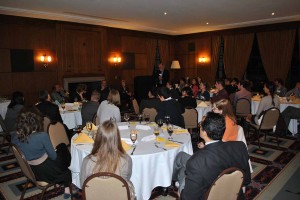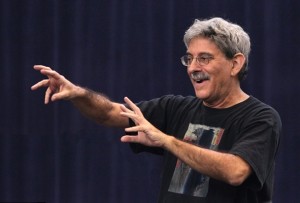Propeller: Was There a Doctor in the House?

You bet. In fact, there were no fewer than 35 of them at Friday night’s performance of Richard III—med students and house officers, all part of the UM Medical Arts Program, a joint UMS–UM Medical School initiative designed to enrich physician training through exposure to the arts and humanities. Funded by the Doris Duke Foundation, the program gives UM medical students and house officers (aka residents) an inside take on concerts, plays, art exhibitions, poetry readings, and so on—all in an effort to deepen their understanding of the human beings they’ll be caring for as physicians.
Joel Howell, professor of internal medicine at UM and co-director of the program, sent this report on the group’s involvement with Propeller:
Last Wednesday evening some 35 medical students and house officers gathered at A2’s Blue Nile Restaurant to enjoy food, drink, and a stimulating discussion of Richard III—the person and the play. Guided by two splendid Shakespeare experts—UM English Professor Barbara Hodgdon and Carol Rutter of the University of Warwick—the group used the play as the starting point to discuss everything from the roots of Richard III’s behavior, to his choice for future matrimony, to what it must be like to confront death. Along the way the discussion was enlivened by images and quotations from the play.
Two nights later the same group attended Richard. Three reactions:
The amazing thing is not so much the production’s obvious connection with a hospital setting, but the holistic way we should be looking at people. It’s very easy for people in medicine to separate themselves from patients. These events underline that we’re all the same.
It was also nice to see that hospital gowns had backs to them. —Sonali Palchaudhuri, third-year UM medical student
I’m doing a rotation in psychiatry now, and I was thinking about how difficult it would be to diagnose Richard, because he’s such a complex character. Any art is a sharp critique of the boundaries and categories we have in psychiatry. —Eunice Yu, third-year UM medical student
Richard III helps to draw into relief how many people outside the medical world see the hospital setting as creepy and scary. The use of masks [in the production] is in sync with that. I thought of how I have to garb when I go into the operating room or the ICU—how that separates us and makes both doctors and patients feel less human. —John Rhyner, house officer
UMS and the Medical Arts Program
The fall of 2010 marked the official kick-off to the Medical Arts program, a collaboration between the University of Michigan Medical School and UMS. The goal of Medical Arts is to enhance the ability of medical students and house officers at U-M to deliver high-quality, humanistic clinical care through the immersion and analysis of specifically designed arts experiences, as well as experience in health care for artists.
On the UMHS side, the program is being led by Dr. Joel Howell and Dr. Sanjay Saint. The arts play a significant role in each of their lives, and they know first-hand how powerful it can be in physcian training. During the pilot of this program last year, Dr. Howell and Dr. Saint exposed students to multiple art forms, in addition to the UMS season – from trips to UMMA to book discussions and poetry readings. Both Dr. Howell and Dr. Saint work with visting artists, and UMS’s Director of Education, Claire Rice, to design the artist/medical student interactions that are fun, challenging, and rich in links between the two fields.
The Medical Arts program received a National Creative Campus Innovations grant from the Association of Performing Arts Presenters (APAP) funded in part by the Doris Duke Foundation last summer, based on its highly-successful and oversubscribed pilot-program entitled “Medicine and the Arts.”
Participants in the program will have many opportunities to draw links between their work in the medical field and that of the artists with whom they engage. Benchmarks for project success could include decreases level of self-reported burnout and cynicism, higher levels of professionalism, and a measurable increase in the participants’ awareness and responsiveness to the needs of their patients.
Although the comprehensive evaluation and research component of this project won’t fully kick in until next season, some very unique and engaging experiences have been created for participants in year one. In October, participants shared dinner and discussion with members of the Takàcs Quartet–a conversation that ended up centering around team work.
In November, visiting artist Stephen Nachmanovich led a workshop on improvisation and free play. A workshop highlight was an activity called the “lemon game” where participants were split into two groups of 15. They were then blind-folded, handed a lemon labeled with a number and given time to get to know their assigned lemon. Some people focused on getting to know every indentation and ridge of their lemon, while some focused more broadly on weight or overall shape.
Others spent time getting to know other people’s lemons in order to differentiate their own. The lemons were then collected and placed together in a grocery bag in the center of each group. You can guess what comes next—with their blindfolds off, participants had to find their lemon amongst their group members’ lemons. AND surprisingly enough, the accuracy rate of finding the correct lemon was almost 100% among the two groups of participants. This activity, and others like it, prompted an important conversations about communication–about listening, meditation, and using every sense at your personal disposal.
The feedback from participants in the Medical Arts program this year has been inspiring to say the least. Here are some highlights from the feedback we’ve received:
What connections did you perceive between your experience with Stephen Nachmanovich and your medical world?
“The experience with Stephen Nachmanovich cultivated simple but fundamental insights into how we live our days our humans and how we percieve the world as physcians. I truly see the exercise as a form of meditation, of increased awareness of the present moment. Such meditative awareness I think is invaluable to personal health, maintaining balance in a busy life, and being a physician who is present with and effectively connects with patients.”
What did you enjoy most about your dinner and performance experience with the Takàcs Quartet?
“Being able to talk to the Takács quartet as a group to foster good correlations between the health and arts, and then being able to extend those ideas in a more personal setting as they sat at the table with us. The performance was then even more meaningful as I was constantly reminding myself of the hard work and passion they put into their performance and what beauty came out of it, and how this could be applied to my career.”
We look forward to rounding out the first year with some very special experiences this winter and spring. In total, there will be approximately eight different sessions touching on a variety of different disciplines and art forms.
Upcoming Events:
Next week, program participants will be engaging with legendary director Benjamin Bagby of Sequentia for dinner and discussion. Conversation will focus around how his research into the the music, literature, and thought of the time informs his creative process. During this period, science and the arts were not seen as being as separate as today, and we will discuss with Bagby what links can be drawn between music and medicine.
In February, participants will have the opportunity to engage with members of the Merce Cunningham Dance Company, including a panel on how an artist’s creative process changes over a lifetime and how one’s physical aging process impacts the creative process. These themes will continue over dinner with MCDC Executive Director Trevor Carlson, and conclude with the participants attending the live performance the following night.
We’ll look forward to sharing artist and student feedback, and program developments here in the UMS Lobby!




